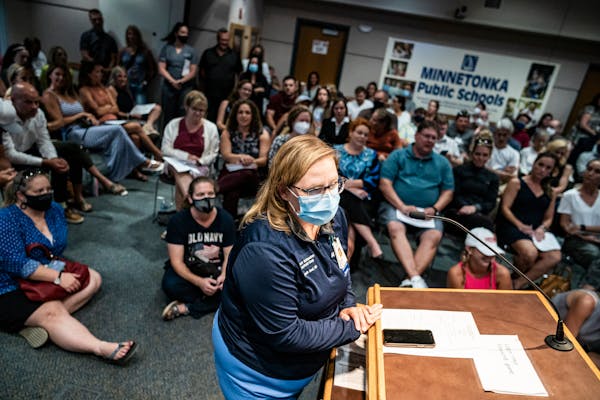Minnesota is spending $40 million in federal pandemic relief to bring in 350 health care workers, mostly nurses, to shore up staffing in hospitals swamped with COVID-19 patients.
Gov. Tim Walz announced the plan Wednesday in response to the worsening omicron wave. Minnesota reported 10,719 more infections Wednesday and a record 19.8% positivity rate of COVID-19 diagnostic tests in the seven days ending Jan. 4.
The funding will pay a staffing agency to bring in caregivers to work 60-hour weeks for two months — hoping that will carry Minnesota through the end of the wave.
"We're going to have a pretty challenging couple of weeks here. That's why we are taking this extraordinary action," Walz said in his announcement outside Regions Hospital in St. Paul. "But all indications are … that once we hit this peak that we should start to come down relatively quickly."
COVID-19 hospitalizations in Minnesota peaked at 1,678 on Dec. 9 and declined to 1,312 on Dec. 31 before rising to 1,508 on Tuesday. Health officials remain encouraged that hospitalizations requiring intensive care haven't increased at the same rate in the latest wave, suggesting that the dominant omicron strain isn't as severe and that vaccine progress is paying off.
Genomic sequencing of a few positive infections has found the omicron variant in 445 COVID-19 cases in Minnesota, including 28 hospitalizations. None involved ICU placements or COVID-19 deaths, but health officials said that will change as those severe outcomes emerge later.
Vaccinated patients tend to have milder cold- or flu-like illness while unvaccinated patients have more severe COVID-19 in the omicron wave, said Dr. Carolyn Ogland, chief medical officer of North Memorial Health. An increase in both types of patients leaves the system's hospitals in Robbinsdale and Maple Grove full at the same time COVID-19 is sidelining staffers.
"We are at record levels again for hospitalizations — like 30 to 33 percent of our hospital patients are COVID patients," she said.
Health Commissioner Jan Malcolm used her authority Wednesday to waive fees and grant flexibility to hospitals and nursing homes to open available beds, which can be staffed by the incoming caregivers.
"With more staffing coming in, we also want to make it possible for physical capacity to be opened up where that makes sense," Malcolm said.
Leaders of eight regional health care coalitions will recommend the hospitals with the greatest need for the stopgap workers, she added. The contract will specify the hiring of new nurses licensed to provide care in Minnesota, not the shuffling of existing nurses in the state.
State Senate Majority Leader Jeremy Miller also met with hospital leaders Wednesday and urged passage of a multistate compact so nurses licensed in other states can work in Minnesota. Walz said he supported the move temporarily in response to the pandemic, though it should have been done last fall when hospitals asked for it amid the delta wave.
HealthPartners, which operates Regions and eight other hospitals, reported 1,000 workers out sick with COVID-19 out of 26,000 total. Regions alone had 90 vacancies for nurses that also contributed to the workforce pressures.
"The need is really clear," said HealthPartners' President and Chief Executive Andrea Walsh. "Our team is stretched. Our care teams have taken extra shifts, they are working longer hours, going above and beyond month after month, and it isn't sustainable."
St. Cloud-based CentraCare has received health care workforce teams from the Minnesota National Guard and the Department of Defense to cover staffing shortages that have worsened amid the omicron wave.
CentraCare has more than 800 workers out sick with coronavirus infections, said Dr. Kenneth Holmen, the health system's chief executive. Critics have questioned whether shortages were exacerbated by vaccine mandates, but Holmen said that hasn't been the root of the problem. CentraCare initially lost 120 workers, including 29 front-line caregivers, when they refused to get vaccinated, but 40 returned.
"There is a remarkable consensus among health care providers in our state that this is the right thing to do," he said, because the mandates protect workers and reduce viral transmissions.
Minnesota on Wednesday reported 49 more COVID-19 deaths, including four people 45-49 years old, one person 35-39, and a Hennepin County resident 25-29. Health officials said most COVID-19 deaths being reported now are lagging tolls of the delta variant wave late last year.
One question about omicron is whether the variant will be so widespread that it will increase the number of "incidental" COVID-19 hospitalizations — patients admitted for other purposes who also turn out to have mild or asymptomatic infections. Recent national estimates have suggested that as many as one-third of COVID-19 hospitalizations could involve such cases.
Even these types of COVID-19 cases place pressure on hospitals, because all infected patients require isolation protocols and extra oversight and lab tests, said Dr. Benji Mathews, Regions' chief of hospital medicine. For some, COVID-19 becomes their primary concern.
"Some of these COVID incidentals become truly catastrophic COVID in the hospital," he said, "and patients we've seen die."
Sanford Health doesn't require COVID-19 testing for admissions, so a patient with a hip fracture isn't going to be tested without respiratory symptoms, said Dr. Jeremy Cauwels, the system's chief physician. Sanford's case count in its Minnesota and Dakota hospitals is mostly severe COVID-19 as a result, he said, and continues to show the benefit of vaccination.
Of 208 COVID-19 patients admitted to Sanford hospitals on Tuesday, 167 were unvaccinated. Of the 60 in intensive care, 53 were unvaccinated.
Carolyn Parnell, 'trailblazer' who served as Minnesota's first IT commissioner, dies


